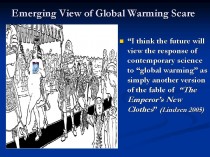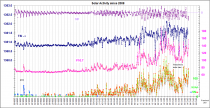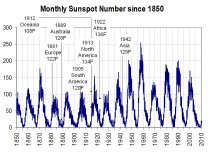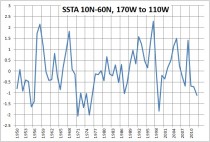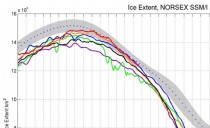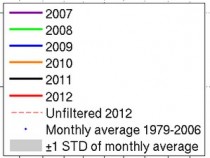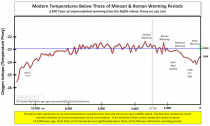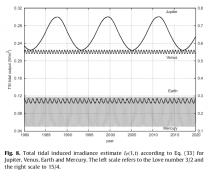By Alan Caruba
There are books that have doomed millions to death. “Das Capital” by Karl Marx kicked off the worst economic system of the modern era, claiming the lives of millions of Russians and Chinese, along with others in the process.
Hitler’s “Mein Kampf” mobilized Nazi Germany, led to World War Two in Europe, and was responsible for the deliberate killing of six million Jews and another five million Christians in its concentration camps, not counting the millions more in war dead. The Nazi leaders were ardent environmentalists.
This year marks the 50th anniversary of the publication of “Silent Spring” by Rachel Carson; a book that is credited with giving rise to the environmental movement in general and, in particular, America’s unfounded fears of pesticides, especially DDT.
Eight years would pass between its publication and the first Earth Day in 1970 that mobilized the beginning of the environmental movement by putting government muscle behind it with the creation of the Environmental Protection Agency.
“Silent Spring at 50: The False Crises of Rachel Carson” ($25.95, Cato Institute) has a publication date in September, but given the June 20-12 Earth Summit in Rio de Janeiro, it is particularly timely. Its chapters had titles like “Elixirs of Death”, “Needless Havoc”, and “Rivers of Death.” What their content lacked was real science and real facts.
DDT was already famous for protecting human health along with a whole range of agricultural chemicals that protected crops against the depredation of insects, rodents and weeds. The book has rightly been condemned for the deaths- literally millions - that have resulted since the 1972 U.S. ban of DDT by the Environmental Protection Agency. It “was firmly and repeatedly warned by public health officials of the United States, the World Health Organization, and the Pan American Health Organization of disastrous consequences of a DDT ban.”
Even today, the EPA either manufactures or ignores evidence to justify its regulations.
Its inventor, Dr. Paul Muller, received a Nobel Prize in 1948 in recognition of the role DDT played in saving hundreds of thousands of lives of troops fighting the Axis in World War Two and the survivors of the Nazi death camps. It killed the insects that spread Typhus and other diseases. It did so without any evidence of the bogus threat of cancer that Carson advanced.
Nine contributors to “Silent Spring at 50” make a powerful case for the harm Carson’s obsessive fear of what were widely known to be beneficial chemicals. The book is a classic example of bogus science combined with deliberate lies to frighten people. That has always been the modus operendi of the environmental movement.
“Carson would have known of the great public health achievements of DDT and that it was saving lives,” writes Donald R. Roberts and Richard Tren, the authors of one chapter. “Indeed she describes some of the programs in “Silent Spring.” But the bulk of the book is a singular attack on DDT and other insecticides with scarcely any recognition of their actual and potential benefits.”
In the first chapter of “Silent Spring”, titled “A Fable for Tomorrow”, Carson invents a town so poisoned by insecticides that no birds sing there, having all been wiped out. It is pure fiction. Subsequent studies have demonstrated that the die-off she described has never happened. Years of bird counts refute that charge. Indeed, agricultural pesticides had initially been regulated by Congress in 1910 and generations of farmers took care to avoid contaminating their crops for obvious reasons.
The anniversary of the book’s publication is relevant to everyone today, even those born since the DDT ban. The coast-to-coast plague of bedbugs that has occurred in the past decade and continues today could have been eliminated if DDT was still in use. The mainstream media reported the plague, but never mentioned this salient fact, nor the fact that the EPA has just one pesticide registered for use against bedbugs and routinely refused to allow licensed pest control professionals to use it.
Carson kicked off “the precautionary principle” cited by environmental groups and government agencies that, in effect, leaves the public defenseless against the health threats that Mother Nature provides in the form of insects and rodents known to spread disease, or mold-contaminants such as aflatoxin, many times more toxic than the fumigant that was banned to control it.
Malaria, once on the brink of being eliminated, has long since made resurgence since the ban of DDT, although some nations most affected by the disease have received permission to use it.
That is Rachel Carson’s true and lethal legacy.
It is why so much of what the environmental movement advocates, from the United Nations to non-governmental-organizations like Greenpeace, the Sierra Club, Friends of the Earth, the World Wildlife Fund, and dozens of others always seems to end up killing people in the name of saving the Earth.
By Anthony Watts, Watts Up With That
There’s more ugliness like what went on recently with Oregon State University. This professor exposed corruption within the California University system that had ties to the California Air Resources Board’s botched PM2.5 rules. As we’ve seen recently, this PM2.5 regulatory action is so vile that the EPA does unannounced human experimentation.
From WND:
What’s academia’s response to a whistleblower who exposes fraudulent research and faked credentials on a panel of experts?
Fire the whistleblower, of course.
That’s the allegation in a new complaint filed against the regents of the University of California by the American Center for Law and Justice on behalf of former professor James E. Enstrom.
The lawsuit explains that Enstrom was a UCLA research professor for decades - until he blew the whistle on “junk environmental science and scientific misconduct at the University of California” and was dismissed.
“The facts of this case are astounding,” said David French, senior counsel for the ACLJ. “UCLA terminated a professor after 35 years of service simply because he exposed the truth about an activist scientific agenda that was not only based in fraud but violated California law for the sake of imposing expensive new environmental regulations on California businesses.”
French said, “UCLA’s actions were so extreme that its own Academic Freedom Committee unanimously expressed its concern about the case.”
…
The lawsuit filed in federal court in Los Angeles alleges the school violated Enstrom’s constitutional rights under the First and 14th Amendments.
Enstrom’s Ph.D. from Stanford is in physics. He’s worked in the university system for more than 30 years. His difficulties started after his peer-reviewed inhalation toxicology report titled “Fine Particulate Air Pollution and total Mortality Among Elderly Californians 1973-2002,” the claim explains.
That study “found no relationship between PM2.5 (particulate matter) and total mortality in California,” the lawsuit said.
His finding contradicted the opinions of “several senior… faculty members. [Environmental Health Sciences] chair Jackson, EHS professors John Froines and Aurthur Winer, epidemiology and EHS professor Bente Ritz, and Dean Rosenstock have all publicly supported the widely popular - though scientifically unfounded - argument that diesel particulate matter and/or PM2.5 results in increased mortality risks for California citizens.”
Enstrom then contradicted the other researchers in testimony to the state legislature and further exposed the fraudulent credentials of Hien T. Tran, “a key CARB scientist and lead author of the October 24, 2008 CARB report on PM2.5 and premature death.
“Mr. Tran’s research report served as the primary public health justification for a new diesel vehicle regulatory scheme approved by CARB ... Dr. Enstrom’s statements brought to light that Mr. Tran’s Ph.D. was not awarded by the University of California at Davis as Tran claimed. Mr. Tran subsequently admitted that he purchased his Ph.D. at a cost of $1,000 from ‘Thornhill University,’ a fake institution and Internet diploma mill based at a UPS store in New York.”
The complaint also asserted that members of a university committee had been serving indefinite terms, in violation of state rules limiting terms to three years.
More from WMD
--------------
An essay in 2009 lays out why Enstrom was right:
California Ignores Scientific Protests, Passes New Diesel Regulations
John Dale Dunn, M.D., J.D., January 1, 2009
Claiming their action will save thousands of Californians’ lives and reduce health care expenditures, the California Air Resources Board has imposed new emission regulations on diesel trucks despite objections from an array of experts about the regulatory process and the credibility of the science.
Vigorous protests of the new regulations and the claims of benefits were submitted by Dr. James Enstrom of UCLA and others, amounting to more than 100 pages of written criticisms of the CARB scientific process and the studies that CARB claimed showed thousands of deaths from diesel small particles.
The year-long process of development of the new regulations resulted in some very revealing public commentary, accusations of complicity in the scientific review process, and even misconduct by CARB officials.
In the biggest scandal, opposition scientists found the lead author of the key study by CARB had faked his Ph.D. and lacked expertise in air pollution research. In addition, CARB hired reviewers to review their own papers, naturally resulting in approval of the scientific studies that claimed the death and health effects.
Dr. Henry Miller, a senior fellow at the Hoover Institution of Stanford University, in a May 27, 2008 essay in The Washington Times, declared the new regulations, called the “Goods Movement Emission Reduction Plan” (GMERP), an overreach by CARB based on bad science that will drive business out of California.
Miller cited a large and detailed 2005 study by Enstrom, who has a real Ph.D. from Stanford and a Masters in Public Health from his current university, UCLA. Enstrom found no death effect in the period between 1983 and 2002 from fine particulate matter in the air.
In any fair analysis of science, such a study disproves the claims of CARB of thousands of deaths. Miller pointed out the harm to the California economy created by the new CARB rules will induce additional deaths due to the “income effect.” Miller, a physician and public health researcher, relates that it is well-established that premature deaths come to people suffering economic hardship and deprivation.
In a valiant effort to push back on the CARB diesel regulations, Enstrom and others provided commentary and analysis in 2008 that showed the CARB scientific process was poisoned with bias and insider dealing, including a review panel that was clearly not objective and was set up to give CARB what it wanted.
During the effort to urge CARB to reconsider the bad effects for little benefit, the Enstrom group found out the lead author for CARB on the study, Hien Tran, in fact did not have the Ph.D. claimed by CARB in its major study of air pollution and that he had authored no significant studies in air pollution toxicology.
On December 10, 2008, in a last effort to change CARB votes and ask for reconsideration of the new regulations with a more disciplined peer review and scientific process, Enstrom authored a letter to CARB reminding the board of the public comments submitted already by many distinguished scientists.
Enstrom noted CARB had not adequately responded to the many criticisms in the public comments raising process and evidentiary questions and refutations of the CARB claims of thousands of deaths. Submitters included Joel Schwartz from the American Enterprise Institute, Joseph Suchecki of the Engine Manufacturers Association, Dr. Suresh Moolgavkar, a prominent and nationally known epidemiologist, Dr. Fred Lipfert, also a national figure in public health, and Dr. John Dunn (the author of this essay), a 30-plus-year epidemiologist from UCLA.
They all asserted the CARB death projections were the product of an excessive zeal at CARB and unacceptably weak research on current California air pollution health effects. Moreover, the commentators pointed out the GMERP rules would impose new regulatory and economic burdens on industry and business that would result in hardship for the consuming public and harm the failing and frail California economy.
The public commentary, mostly from scientists and more than 140 pages, was negative, with the expected supportive letters from environmental organizations.
In his December 10 letter, Enstrom pointed out CARB’s disregard of public scientific commentary, the biased nature of the CARB consultants, lack of scientific qualifications of CARB lead author Hien Tran, and reasons why CARB should reconstitute its review process and committee members and restudy its scientific reports and projections of deaths.
In another December 2008 letter to CARB board members, Enstrom, Anthony Fucaloro, a 35-year chemist from Claremont McKenna University, Matt Malkan, a 25-year astrophysicist from UCLA, and Robert Phalen, a 35-year air pollution toxicologist from UC Irvine, pointed out their concerns:
--------
General Concerns Regarding Air Pollution Health Effects and Regulations
1) Pollution levels are much lower today than in previous decades and current health risks are small.
2) Small epidemiologic associations are often spurious, rather than cause-and-effect relationships.
3) Regulations designed to solve one problem may have consequences that do more harm than good.
4) Scientists who are not popular activists are often marginalized and their important research is ignored.
5) Conflict of interest regarding power and funding exists between regulators and conforming scientists.
6) New regulations must be based on a fair evaluation of all available evidence from diverse sources.
Specific Concerns Regarding October 24, 2008 CARB Staff Report on PM 2.5 and Premature Deaths
1) Authors have no relevant peer-reviewed publications and lead author has misrepresented his “Ph.D.”
2) Report and public comments were never shown to outside reviewers as stated in Executive Summary.
3) Five independent sources indicate no current relationship between PM2.5 and deaths in California.
4) California has fourth lowest total age-adjusted death rate among US states and few “premature deaths.”
5) Diesel toxicity and fine particulate air pollution in California are currently at record low levels.
6) Before approving new diesel regulations, CARB should fully evaluate PM2.5 and deaths in California.
Conclusion
Important epidemiologic and toxicological evidence does not support adverse health effects of diesel claimed by CARB and new diesel regulations should be postponed until the above issues are fully and fairly evaluated.
----------
The CARB board passed the rules unanimously. So much for the democratic process and scientific debate that results in good public policy.
John Dale Dunn MD JD
Consultant Emergency Services/Peer Review
Civilian Faculty, Emergency Medicine Residency
Carl R. Darnall Army Med Center
Fort Hood, Texas
Richard Feynman explains the scientific method in 1964 lecture (thanks to Geek.com)
You might not know exactly who Richard Feynman is, but he’s probably affected your life. Feynman was a fabulously famous (in certain circles) theoretical physicist in the mid-late 20th century. He worked on the Manhattan Project to develop the atomic bomb, pioneered particle physics, won a Nobel Prize, and popularized science through books and his own warm persona. In this video from 1964, you can get a glimpse of what made Feynman so notable as he explains the concept of the scientific method to his students.
Everything we hold to be true in science is tested in the same way, and Feynman explains it wonderfully here. No matter how smart a person is, no matter how elegant their hypothesis, if it does not agree with experimentation, it is wrong. Feynman calls this the “key to science.” Guessing is not unscientific, though it may seem that way to non-scientists. Rather, it would be unscientific to just accept a guess because it is comforting or easy.
The data we have changes over time, so Feynman cautions his students to be aware they may only prove things to temporarily right. Science corrects itself over time as more experimental methods and techniques are developed. It took hundreds of years for Newton’s laws governing the motion of planets to be refined as small errors were fleshed out. Essentially, we hold scientific concepts (or parts of concepts) to be right until such time as the data no longer supports the hypothesis. This is what sets science apart from other ways of understanding the world; it actively seeks to correct errors.
Feynman gives a great explanation of the scientific method here that still holds up today. I don’t know about you, but I find today’s professors aren’t quite as personable as the late Richard Feynman. ICECAP NOTE: Or insightful or honest nor do they teach you how to think but what to think. As Socrates said “Education is the kindling of a flame, not the filling of a vessel” - Socrates (470--399 BC)
Seeing he is like the boy who ackowledged the King was without clothers, modern scientists and mainstream (lamestream media) looks for flaws in his background.
Feynman FBI Files: Newly Released Documents Put Spotlight On Physicist Richard Feynman
Huffington Post
Published: 06/15/2012 09:21 AM EDT on LiveScience
Physicist Richard Feynman helped create the atomic bomb, shared a Nobel Prize for his work on quantum electrodynamics, and helped to figure out the source of the space shuttle Challenger explosion.
But he was also subject to scrutiny by the U.S. Federal Bureau of Investigation, as it sought to uncover communist sympathizers during the 1950s.
Now, documents from Feynman’s FBI file have been released and posted at MuckRock.com, a site dedicated to public records requests.
The FBI began keeping an eye on Feynman after other members of the Manhattan Project, which built the first atomic bomb, turned out to be Soviet spies, including Klaus Fuchs, the project’s primary physicist. The documents, 361 pages, record statement after statement from the physicist’s friends and colleagues, mostly praising Feynman for his brilliance, trustworthiness and loyalty to the country.
The documents available at MuckRock detail, for example, how in 1958 Feynman, then at Caltech, received an invitation from the Soviet Union to attend a physics conference in Moscow. After discovering this invitation by sifting through the Soviet ambassador’s trash, the FBI began looking into his plans.
Feynman, meanwhile, delayed accepting it and sought guidance from the State Department, which forwarded his letter to the FBI but waited months before responding, according to MuckRock. In 1958, the FBI conducted a routine background investigation on Feynman when he was being considered for President Eisenhower’s Science Advisory Committee. Reports and memos, including newspaper articles mentioning the physicist, revealed more about Feynman’s brilliance as a physicist and some of his personal interests and drawbacks.
For instance, an FBI report dated July 21, 1958, based on information from a Cornell faculty member and colleague of Feynman’s stated that Feynman “was one of the outstanding physicists in this country and in spite of some of his personal habits, he felt that there was no question concerning his loyalty, responsibility, discretion, or associates.”
The report went on, “He stated that Professor Feynman was an accomplished jazz drummer and believed that this hobby, in the eyes of some individuals, was not in keeping with Feynman’s role as a professor of physics.”
In a note to the director of the FBI, dated July 29, 1958, Special Agent-in-Charge (SAC) Los Angeles notes details from an LA Times article from two years prior, regarding his relations with his wife: “The appointee’s wife was granted a divorce from him because of appointee’s constantly working calculus problems in his head as soon as awake, while driving car, sitting in living room, and so forth, and that his one hobby was playing his African drums. His ex-wife reportedly testified that on several occasions when she unwittingly disturbed either his calculus or his drums he flew into a violent rage, during which time he choked her, threw pieces of bric-a-brac about and smashed the furniture.”
Apparently, another of Feynman’s quirky traits: He was a whiz at cracking safes and picking locks, according to the released documents.
They know “sustainable development” really means sustained poverty and malnutrition
By Kelvin Kemm, Eurasia Review
If you want to learn what farmers think (and need), talk to African farmers - not to bureaucrats, environmental activists or politicos at the Rio+20 United Nations summit in Rio de Janeiro. You’ll get very different, far more honest and thoughtful perspectives.
The recent (May 24) Food, Agriculture and Natural Resources Policy Analysis Network conference in Pretoria, South Africa brought together delegates from agricultural communities in many African countries. FANRPAN’s primary objective is to improve food security in Africa, by ensuring that small-scale farmers can become more productive. Their obvious enthusiasm and commonsense views were heartening.
FANRPAN chair Sindiso Ngwenya of Zambia gave an incisive presentation, pointing out that agriculture is the key to reducing poverty and ensuring food security in Africa. “We call upon the world to assist us,” he said, “not by treating us as beggars, but by treating us as equals.”
Ngwenya criticised many First World attempts to use climate change, biodiversity and sustainable development arguments to prevent African agriculture from advancing. “If you are using implements that were there before Christ, how much chance do you have?” he wanted to know.
And why would anyone think these UN-EU-US issues are important to African farmers and families who are trying to feed their families and neighbors, and improve their living standards by exporting their products?
Africa does not need foreign aid in the form of handouts, Ngwenya emphasized. African farmers need modern technology and reliable, affordable electricity. They need the world to buy African produce. Instead, far too often, European and other First World countries impose rules or block African exports, using a multitude of excuses that can no longer be tolerated.
FANRPAN has decided to go “Africa-wide,” Ngwenya announced. Africa is huge - larger than the United States, China, India and Europe combined. And yet 60% of its arable land is not used at all. On the arable land that is used in most African countries, crop yields are typically a quarter of the norm in South Africa. What’s needed, he said, are modern farming methods, seeds, fertilizers and equipment - at the level of every individual farmer.
Referring to the 2011 COP-17 world environment congress in Durban, South Africa, Ngwenya pointed out that the FANRPAN slogan is “No agriculture, no deal.” However, agriculture, and particularly the advancement of rural African agriculture, was not included in past COP objectives. Many delegates criticised this, saying it reflected the First World’s hope that Africa and African agriculture will remain primitive and underdeveloped, so that rich countries can praise Africans for being “sustainable” and protecting the planet.
Africans are being told by First World activists, politicians and pressure groups to “stay in tune with nature,” delegates noted - when this attitude really reflects a well-fed First World’s maneuver to retard African agricultural improvements.
When it came to the eternal climate change saga, FRANRPAN delegates emphasized “climate-smart agriculture” and noted that Africa has always experienced dramatic weather and climate variations. What’s needed now, they stresse, is sensible, fact-based science, to predict and adapt to local and regional climate cycles and variations.
Equally impressive was learning that a group of small-scale farmers from Burkino Faso had paid their own way to attend a meeting in Windhoek, Namibia, nearly 3,000 miles (4,500 kilometers) away, to present a petition calling for the development of evidence-based policies, to replace what to now have been emotional, harmful and oppressive policies, rules and treaties.
The delegates said they were tired of the First World telling them what to do, based on First World interests and perceptions. They understand all too well that calls for “sustainable development,” “biodiversity” and climate change “prevention” really mean demands for policies and practices that ensure sustained poverty and malnutrition.
FRANRPAN CEO Dr. Lindiwe Sibanda emphasized that the real work is done on the ground, at the level of individual countries - and “policy comes from people.” Individual countries must come to their own conclusions about what works for them, and countries must align their policies to ensure food security for their people, she said. Modern methods and technologies are also required, to enhance intra-Africa food trade and enable countries to export what they are good at producing.
Her enthusiasm was praised by a farmer who spoke from the floor, with a strong French accent. “There’s a lack of resources for small farmers to come here,” he said, even for important meetings like this, but he was glad he had spent the time and money to be there. Certainly, those that did attend exhibited enough excitement and enthusiasm for the millions who could not join them.
Chairman Ngwenya wrapped up the proceedings by criticising the apparently intentional side-stepping of agricultural issues during COP-17. The First World must stop impeding African farmers and end “the paralysis by analysis,” he said. Absolutely right.
There is far too much First World smoke and mirrors, telling Africans they are saving the planet - when the real intention is to stop them from acquiring modern technology and electricity that would allow them to surge to middle class or even rich country status.
This FANRPAN conference serves notice to the United Nations Environment Programme, Rio+20 Sustainable Development Summit, Europe, United States and other obstructionists that Africa has caught on to what they are doing - and is no longer willing to play their game.
That’s good news for every African, Asian, Latin American and other poor family that wants to eat better, live better and have the freedom to pursue their dreams.
Dr Kelvin Kemm is a nuclear physicist and business strategy consultant in Pretoria, South Africa. He is a member of the International Board of Advisors of the Committee For A Constructive Tomorrow (CFACT), based in Washington, DC (http://www.CFACT.org). Dr. Kemm received the prestigious Lifetime Achievers Award of the National Science and Technology Forum of South Africa.
See also David Legates essay on this counter intuitive policy
Hello Everyone,
In theory at least Oregon State University (OSU) seems to be a bastion of academic freedom, diversity, and tolerance. A wide range of ideas are openly discussed. The most viable rise to the top and the least viable fade away. But it is all a fairy tale, because OSU operates under a politically correct regimen that dictates what is acceptable to say and what is not. Transgressors who dare to be different are eventually weeded out so that the campus maintains its ideological purity.
OSU is not yet as swift or efficient as the Soviet system when Joseph Stalin was trying to quash dissent among biologists who refused to go along with Trofim Lysenko. If warnings to compromise their integrity were not followed, Stalin simply had biologists shot. That quickly thinned the ranks of all biologists and persuaded the remaining ones to comply with Stalin’s wishes. Of course, it also destroyed Soviet biology, because Lysenko was pedaling nonsense. And Russian biology has never recovered.
We learned over the weekend that chemist Nickolas Drapela, PhD has been summarily fired from his position as a “Senior Instructor” in the Department of Chemistry. The department chairman Richard Carter told him that he was fired but would not provide any reason. Subsequent attempts to extract a reason from the OSU administration have been stonewalled. Drapela appears to have been highly competent and well-liked by his students. Some have even taken up the fight to have him reinstated.
What could possibly have provoked the OSU administration to take precipitous action against one of their academics who has been on their staff for ten years, just bought a house in Corvallis, and has four young children (one with severe medical problems)? Dr. Drapela is an outspoken critic of the theory of Anthropogenic Global Warming, the official religion of the State of Oregon, the Oregon Democratic Party, and Governor John Kitzhaber.
Five years ago, Oregon State Climatologist George Taylor went around quietly saying that he was not a believer. Then Governor Ted Kulongoski and many faculty at OSU including Dr. Jane Lubchenco made life impossible for Taylor, and he retired. (Lubchenco is now head of NOAA in the Obama administration.) Under those currently in charge, OSU climate research has grown to be a huge business, reportedly $90 million per year with no real deliverables beyond solid academic support for climate hysteria. A small army of researchers ponder the effects of Global Warming on all sorts of things from tube worms living along the Oregon Coast to butterflies inland. When the climate refuses to warm (as it has for the last twenty years), they just study ‘warming in reverse!’ Most of us call that “cooling,” but they are very careful not to upset their Obama administration contract monitors with politically incorrect terminology.
Skeptics of Global Warming who oppose the OSU approach and oppose the politicians who make it all possible but do not work for OSU also find themselves attacked. Dr. Art Robinson who is running against Peter DeFazio for an Oregon Congressional seat found three of his children under attack at OSU. All were attempting to obtain advanced degrees in the Nuclear Engineering Department and were threatened with dismissal. Because Robinson fought back, we understand that the OSU administration backed down.
As to the latest victim of political correctness at OSU, Dr. Nickolas Drapela gives us an excellent synopsis of what is going on:
“The fact of the matter is that it is now two weeks since I was fired and no one has had the cajones or the common courtesy to even tell me why. I have spoken with the Dept. Chair (Rich Carter) who fired me, and he refused to tell me why. I spoke to the Dean of Science (Vince Remcho) and he couldn’t tell me why. I spoke to HR who set up a meeting with me, then cancelled it an hour before. Then I went to the Vice President of Academic Affairs (Becky Warner) and she sent me back to Rich Carter, the chemistry chair.
It’s just a sad, sad state of affairs that an institution like OSU would fire a good employee for (ostensibly) no reason and then run around and hide from the person they fired. I had stellar teaching evaluations, I won College of Science awards for teaching, and published textbooks. My class sections were always full and I was well-liked by students (see ratemyprofessors.com). I was doing my job very well. But I guess I didn’t march in step with their philosophies.
There were quite a few student protests over this at OSU (Barometer, Facebook, etc.) but to no avail.
I was given no severance and had no warning this was about to happen. In fact, I was lured into the chair’s office under the guise of a fallacious story before being fired.
As you know, I was probably the most visibly-outspoken critic of the Global Warming doctrine at OSU. I gave several public talks on the topic and did research in the area which I regularly posted on the web. I was also on a few talk radio shows in the area. I think they finally just said, we can’t have this.
Can it be that a university whose motto is “Open minds. Open doors” cannot abide even one faculty member who disagrees with their dogma? I suppose I am too naive, but I’m still reeling from it. Unbelievable.
I should say that they regularly read all my email communications, which is why I am writing from this private email address. That has been going on for quite some time now.
As far as my options at this point, like I said I haven’t even really grasped what has just happened. I don’t know what I’m going to do, or what options I have yet. I’m sure OSU wants their story to be tight and perfectly identical among all administration before coming out with an official reason why I was fired, hence the long wait and refusal to speak to me.
I truly thank you for your concern, and I hope there is some recourse, even just for the sake of exposing what is happening at OSU.”
In a separate e-mail Drapela went on to say:
“Thanks so much for your support and your concern. That’s really nice. My students were all really upset about it. They started an email writing campaign to have me re-hired but I guess no one cares what they think.
I find that the people who want to keep things secret all the time are usually the people that have something to hide. It is certainly ok by me for you to disseminate this story. But I’m sure OSU would be horrified.
I’m not sure how I will support my family at this point. We just bought a house in Corvallis. I have four kids, one of whom has a rare, blood disorder and requires regular trips to Doernbecher’s Children’s Hospital for treatment. Now we will be without health insurance.”
We can only speculate as to how the decision to fire Drapela was made. Unlike the decision to force Taylor out (which came from the governor’s office), this decision was likely internal to OSU with the implicit backing of Governor Kitzhaber and NOAA administrator Lubchenco.
Please join with me in supporting Nick Drapela. Please join with me in supporting objective science, as well as academic freedom, diversity, and tolerance. The issues here go far beyond just Global Warming and strike at the very heart of who we are as scientists and Americans.
Gordon J. Fulks, PhD (Physics)
Corbett, Oregon USA
P.S. Please circulate this e-mail far and wide. The world needs to know what is going on here.
Icecap Note: Voice your opinions about Drapela by contacting
Oregon State University
Corvallis, OR 97331
541-737-1000
See Joanne Nova’s story on this case ”Gone Feudal: Oregon State Uni (OSU) sack and target skeptics (and their children)”
But some good news from Virginia where a dark cloud is following Michael Mann this week with the withdrawal of the seriously flawed (much like MBH) Gergis proxy reconstruction paper by AMS and now perhaps some changes in VA. where Early on Sunday morning (6/10/2012), UVa Alumni received a stunning email sent by Helen E. Dragas, Rector, and Mark Kington, Vice Rector of the University of Virginia Board of Visitors, that conveyed startling news:
On behalf of the Board of Visitors, we are writing to tell you that the Board and President Teresa Sullivan today mutually agreed that she will step down as president of the University of Virginia effective August 15, 2012.
In January of 2010, President Sullivan had been unanimously elected by UVa’s governing Board. Rector John O. Wynne (former TWC President), who had chaired the board’s special committee on the nomination of a President, had described Teresa Sullivan as a person of integrity and vision, and “an extraordinary talent who brings to the University an enormous depth and breadth of experience in every aspect of public higher education.”
Sullivan oversaw the spending of a million dollars in legal fees to fight off the release of Mann’s emails as requested by the FOIA and apparently was offering Mann the first Kington chair. See the WUWT Mannian Paint by the numbers connect the UVA dots.
----------
Journalists Refuse To Discuss The Mammoth In The Room
By Steve Goddard
According to Richard Black of the BBC, global warming is soon to be a $100 billion per year industry. This money pays for and drives the direction of the science.
The press corps(e) drones on endlessly about tiny amounts of imagined big oil money - yet refuses to discuss the scientific corruption caused by unimaginably large amounts of big government money, big bank money, big insurance money, …. etc.
The message for scientists is simple. Give us the answer we are looking for, and we will pay you. Give us the wrong answer and we will fire you. Journalists won’t touch this because they are on same payola scheme.
The big oil lie is propagated by Greenpeace on Sourcewatch and radical environmentalist David Suzuki and renewable industry funded Desmogblog and happily repeated by the journalists in the tank for the left and also by many ill informed commenters on the internet blogs and story sites. It is also behind the criminal behavior of UVA and OSU and PSU in purging skeptical scientists and protecting grant toting alarmist faculty.
Anthoy Watts, WattsUpWithThat
UPDATE: It appears the paper has been withdrawn and credit acknowledgement given to Steve McIntyre, see below:
There was yet another recent “hockey stick” being foisted on the public. Gergis et al.
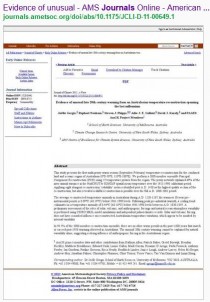
Enlarged
It says:
The average reconstructed temperature anomaly in Australasia during A.D. 1238–1267, the warmest 30-year pre-instrumental period, is 0.09C (plus/minus 0.19C) below 1961–1990 levels.
Basically, another “ah-ha, man is at fault” pitch.
At Climate Audit, the paper was examined in more detail, and alarm bells went off. Concern centered around the 27 proxy data sets used in the study. Now, after Steve McIntyre found some major faults, it seems this paper has gone missing from the AMS website without explanation. All that remains is the Google cache thumbnail image, not even the cached web page. See below:
Here is the original URL.
Here’s a backup copy.
To read about how the takedown came about, I suggest this excellent summary from Bishop Hill as the technical details are rather thick: Another Hockey Stick broken
The problems with the paper in a nutshell:
1.upside down proxy data again
2.preselection of data, ignoring the whole set in many cases
3.though they tried to justify preselection, the paper’s methodology doesn’t hold up (circular reasoning)
4.inability to replicate given the data and methods used
In Gergis defense, they provided full *some documentation and data at the outset, unlike some other hockey stick purveyors we know. This allowed the work to be checked independently. This is how science is supposed to work, and apparently it has.
(*Added: apparently Gergis refused some additional data Steve McIntyre requested, the documentation of this on his CA website)
It appears from my perspective that this is a failure of peer review at the AMS.
UPDATE: Further proof that the paper has truly been taken down, and this isn’t a web glitch.
1. The DOI link is also broken over at Real Climate in their article: Fresh hockey sticks from the Southern Hemisphere
References
1. J. Gergis, R. Neukom, S.J. Phipps, A.J.E. Gallant, and D.J. Karoly, “Evidence of unusual late 20th century warming from an Australasian temperature reconstruction spanning the last millennium”, Journal of Climate, 2012, pp. 120518103842003-. DOI.
2. On the AMS search page.
I put in both the author name and the DOI, and got nada:
Search Results
Search Query: Authors: gergis
Your search did not match any articles.
Search Query: PubIdSpan: JCLI-D-11-00649.1
Your search did not match any articles.
===========
UPDATE2: Steve McIntyre reports the paper has been put “on hold”
NASA MSFC
The current prediction for Sunspot Cycle 24 gives a smoothed sunspot number maximum of about 60 in the Spring of 2013. We are currently over three years into Cycle 24. The current predicted size makes this the smallest sunspot cycle in about 100 years.
The prediction method has been slightly revised. The previous method found a fit for both the amplitude and the starting time of the cycle along with a weighted estimate of the amplitude from precursor predictions (polar fields and geomagnetic activity near cycle minimum). Recent work [see Hathaway Solar Physics; 273, 221 (2011)] indicates that the equatorward drift of the sunspot latitudes as seen in the Butterfly Diagram follows a standard path for all cycles provided the dates are taken relative to a starting time determined by fitting the full cycle. Using data for the current sunspot cycle indicates a starting date of May of 2008. Fixing this date and then finding the cycle amplitude that best fits the sunspot number data yields the current (revised) prediction.
Predicting the behavior of a sunspot cycle is fairly reliable once the cycle is well underway (about 3 years after the minimum in sunspot number occurs [see Hathaway, Wilson, and Reichmann Solar Physics; 151, 177 (1994)]). Prior to that time the predictions are less reliable but nonetheless equally as important. Planning for satellite orbits and space missions often require knowledge of solar activity levels years in advance.
A number of techniques are used to predict the amplitude of a cycle during the time near and before sunspot minimum. Relationships have been found between the size of the next cycle maximum and the length of the previous cycle, the level of activity at sunspot minimum, and the size of the previous cycle.
Among the most reliable techniques are those that use the measurements of changes in the Earth’s magnetic field at, and before, sunspot minimum. These changes in the Earth’s magnetic field are known to be caused by solar storms but the precise connections between them and future solar activity levels is still uncertain.
Of these “geomagnetic precursor” techniques three stand out. The earliest is from Ohl and Ohl [Solar-Terrestrial Predictions Proceedings, Vol. II. 258 (1979)] They found that the value of the geomagnetic aa index at its minimum was related to the sunspot number during the ensuing maximum. The primary disadvantage of this technique is that the minimum in the geomagnetic aa index often occurs slightly after sunspot minimum so the prediction isn’t available until the sunspot cycle has started.
An alternative method is due to a process suggested by Joan Feynman. She separates the geomagnetic aa index into two components: one in phase with and proportional to the sunspot number, the other component is then the remaining signal. This remaining signal has, in the past, given good estimates of the sunspot numbers several years in advance. The maximum in this signal occurs near sunspot minimum and is proportional to the sunspot number during the following maximum. This method does allow for a prediction of the next sunspot maximum at the time of sunspot minimum.
A third method is due to Richard Thompson [Solar Physics 148, 383 (1993)]. He found a relationship between the number of days during a sunspot cycle in which the geomagnetic field was “disturbed” and the amplitude of the next sunspot maximum. His method has the advantage of giving a prediction for the size of the next sunspot maximum well before sunspot minimum.
We have suggested using the average of the predictions given by the Feynman-based method and by Thompson’s method. [See Hathaway, Wilson, and Reichmann J. Geophys. Res. 104, 22,375 (1999)] However, both of these methods were impacted by the “Halloween Events” of October/November 2003 which were not reflected in the sunspot numbers. Both methods give larger than average amplitude to Cycle 24 while its delayed start and low minimum strongly suggest a much smaller cycle.
The smoothed aa index reached its minimum (a record low) of 8.4 in September of 2009. Using Ohl’s method now indicates a maximum sunspot number of 70 plus/minus 18 for cycle 24. We then use the shape of the sunspot cycle as described by Hathaway, Wilson, and Reichmann [Solar Physics 151, 177 (1994)] and determine a starting time for the cycle by fitting the latitude drift data to produce a prediction of the monthly sunspot numbers through the next cycle. We find a maximum of about 60 in the Spring of 2013. The predicted numbers are available in a text file, as a GIF image, and as a pdf-file. As the cycle progresses, the prediction process switches over to giving more weight to the fitting of the monthly values to the cycle shape function. At this phase of cycle 24 we now give 66% weight to the amplitude from curve-fitting technique of Hathaway, Wilson, and Reichmann Solar Physics 151, 177 (1994). That technique currently gives similar values to those of Ohl’s method.
Note: These predictions are for “smoothed” International Sunspot Numbers. The smoothing is usually over time periods of about a year or more so both the daily and the monthly values for the International Sunspot Number should fluctuate about our predicted numbers. The dotted lines on the prediction plots indicate the expected range of the monthly sunspot numbers. Also note that the “Boulder” numbers reported daily at http://www.spaceweather.com are typically about 35% higher than the International sunspot number.
Another indicator of the level of solar activity is the flux of radio emission from the Sun at a wavelength of 10.7 cm (2.8 GHz frequency). This flux has been measured daily since 1947. It is an important indicator of solar activity because it tends to follow the changes in the solar ultraviolet that influence the Earth’s upper atmosphere and ionosphere. Many models of the upper atmosphere use the 10.7 cm flux (F10.7) as input to determine atmospheric densities and satellite drag. F10.7 has been shown to follow the sunspot number quite closely and similar prediction techniques can be used. Our predictions for F10.7 are available in a text file, as a GIF image, and as a pdf-file. Current values for F10.7 can be found at: http://www.spaceweather.ca/sx-4-eng.php.
----------------------
Leif Svalgard maintains a summary of all the parameters.
----------------------
Jan Janssens adds
You may want to consult my webpage “Evolution of SC24”.
Besides sunspot numbers, it tracks also solar flares, geomagnetics, radio flux, cosmic rays,…
An overview of SC24-predictions (made prior to 2009 = prior to SC-minimum) can be found at this link.
At this time (only 40 months after cycle minimum), we have not reached SC24-maximum yet. This is expected to occur in the first half of 2013.
Currently, we seem to be in a standstill very similar to what happened during SC23 (albeit this time later in the cycle and at a lower sunspot level:
see).
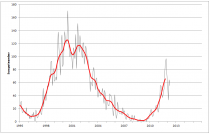
BTW, all of the continental heat extremes occurred in the lower solar periods.
This is because the meridional patterns seem to persist when the sun is less active. That partially explains the persistant cold in the Paciifc Northwest down to coastal California while areas to the east have been stuck warm. The second strongest La Nina in 110 hears is also likely playing a role resulting in an enhanced cold PDO with cold water off the west coast and warm north of Hawaii. This helps maintain a western trough and downstream ridge. That appears to be breaking down as El Nino comes on now as it did in 2009.
Here is a plot of the water anomalies in the eastern Pacific.
The pendulum is likely to swing as it did in 2009. By the way the last regime with waters cold in the east was the early 1970s, a period where the Atlantic was cold. That made a difference. As now we are in the warm mode which favors continental warmth in summer in the Northern Hemisphere. But this last year has been US specific.
NOAA making big deal about last 12 months being the warmest ever. John Christy provides color.
Here are the sectors from MSU TLT in deg C. Max12mo is highest 12-month average value beginning with Dec78-Nov79 and going forward month by month. Right column is latest 12-month running mean (Jun2011-May2012). Latest USA48 is essentially tied with the value from Oct1999-Sep2000. The USA48 is the interesting story because other sectors (larger) are less than half of hottest value. Note at bottom - Alaska was well below average for Jun2011-May2012 (record low was -1.131 C, and doing this quickly I couldn’t add in the small part adjacent to BC.)
Sectors
Trpcs 20S-20N
NoExt 20N-85N
SoExt 85S-20S
Pol 60 to 85
UAH LTv5.4
Region............ Record Max............Last Year

Remember NASA GISS’s own words:
“"Everyone appears also to agree that too much attention is paid to records, particularly given that the difference between 1934, 1998, and several other sets of years in the top 10 warmest list for the United States are so small as to be statistically meaningless.”
Dr. Hansen and his team note that they rarely, if ever, discuss individual years, particularly regional findings like those for the United States (the lower 48 are only 2 percent of the planet’s surface). “In general I think that we want to avoid going into more and more detail about ranking of individual years,” he said in an e-mail message. “As far as I remember, we have always discouraged that as being somewhat nonsensical."”
By P Gosselin on 3. Juni 2012
An honest look at the data allows us to conclude only one thing: The path to protecting the planet is paved with energy and human prosperity. A shortage of either would mean big trouble for the environment.
How Much Power Should We Consume?
By Ed Caryl
There have been many suggestions here on this blog, and elsewhere, that the aim of the CAGW hoax is population control.
It is obvious that the poor people of the world produce more babies; witness Africa with a birth rate much higher than the rest of the world but a very low GDP. The Africans would seem to be the model for what the Greens want the world to be: a low carbon footprint. But with their high birth rate and low production, most of Africa teeters on the brink of famine. Unable to afford energy and sanitation, many burn forests and dump their waste untreated into the environment. This would suggest that the “low carbon footprint” model is only a recipe for disaster.
On the other hand, countries with well developed economies have low birth rates but high carbon footprints. If we are to reach a stable population, one that can be sustained far into the future, a world-wide well developed economy will be required.
A well developed economy requires energy. Producing food, goods, keeping people warm or cool, assuring hygiene, and providing transportation for people, food, and products, require energy.
What are the relationships between population growth, energy consumption, and production? First, here’s a chart of electricity consumed versus GDP (Gross Domestic Product) per person for 202 countries. (Source for all the numbers in these charts is the CIA World Factbook.) Electrical power consumption can be considered a proxy for all energy consumption.
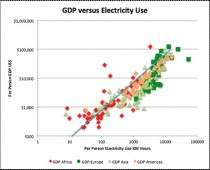
Figure 1: Per person GDP as a function of electricity use.
It is clear from Figure 1 that to have a well developed economy with a high GDP, energy consumption must also be high. A rough trend can be seen: each KW hour produces about $10 GDP per person. The average GDP per kilowatt-hour for all countries is $8.31. The ten highest electrical power users per person are: Iceland, Norway, Kuwait, Canada, Finland, Sweden, United Arab Emirates, Luxembourg, United States, and Australia. Oil production in Africa and the Middle East distort some of the GDP numbers.
What does a high GDP do to birth rate?

Figure 2: As per capita GDP rises, fertility rates (children per woman) fall.
In Figure 2, a fertility rate of 2 is the replacement level. Fertility rates below 2 indicate a declining population. Above 2 there is an increasing population. As you can see, most of Africa is poor and pregnant. African countries that are not poor are oil producers like Libya and Nigeria. Most European populations are in decline. The exceptions are Andorra and Gibraltar. Asian countries with thriving economies are below the replacement value. Singapore is the bottom point on fertility with a rate of 0.78 children per woman. South Korea, Taiwan, Hong Kong, and Macau are just above that number.
There is a third leg to our stool: the relationship between fertility rate and electrical power. The next chart shows that relationship.
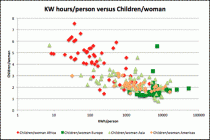
Figure 3. The more power people consume, the less children they have.
Again, most of Africa, and some of Asia, is pregnant and powerless. It should be clear by now that there is an optimum electrical power and GDP necessary to result in a sustainable, stable population. Those numbers would appear to be about 3,000 KW hours and a GDP of about $30,000 annually per person. The total population is about seven billion. Therefore:
7 billion X 3,000 KWh = 21 trillion KWh.
21 trillion kilowatt-hours would seem to be a reasonable target. The world currently produces 19 trillion kilowatt-hours of electricity. It appears that about 10% more electrical energy, with the accompanying improvement in GDP, primarily in Africa and some parts of Asia, would go a long way toward improving the quality of life and stabilizing population in those areas.
Energy drives civilization. This fundamental should be obvious to all, but apparently has not penetrated the consciousness of Greens, Progressives, and warmist zealots. Man builds cities to concentrate people, jobs, markets, and energy use into more efficient areas. Energy allows more efficient production, including food, technology, housing, and transportation. Cities and energy encourage creativity and innovation. More energy means a higher Gross Domestic Product.
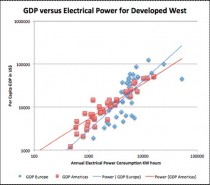
Figure 4: GDP as a function of electrical power usage, for Europe and the Americas.
Figure 4 shows a clear relationship between GDP and electrical power consumption. If less electricity is generated, the cost of electricity will go up (due to the economic law of supply and demand), less will be used, and GDP will go down. The converse is, of course, more desirable: more power and reducing the cost, will result in a higher GDP. High priced wind and solar is not the answer. Let the market decide how to generate more power efficiently.
For those that are screaming “what about carbon footprint!”, the market will very soon take care of that non-problem. We are currently passing the “peak oil” point. Fossil fuels, in the long term, will be a declining portion of our power production. Barring governmental stupidity, nuclear power will be an increasing percentage of energy production.
Due to the fact that carbon dioxide is a vital plant food, as well as a minor greenhouse gas, sometime in the not too distant future we will be developing schemes to keep the atmospheric CO2 level above 400 ppm or higher.
By Lubos Motl, the Reference Frame
Radiative cooling (and warming) isn’t a key effect: a piece of the man-made climate change “lore” is shaken
This particular paper which may have isolated a major mistake in the would-be mainstream “lore” of the climate science - and in all the climate models - hasn’t gotten a sufficient amount of attention in the climate blogosphere. An article by The Hockey Schtick at the end of April and The Orange Punch yesterday are two exceptions.

A polar stratospheric cloud.
We’re talking about a paper in Atmospheric Chemistry and Physics that studied the conditions under which the clouds form in an upper layer of the atmosphere above the Arctic (the stratosphere):
On the linkage between tropospheric and polar stratospheric clouds in the Arctic as observed by space-borne lidar (PDF full text for free) If you need to know, a lidar is a radar that is emitting light waves instead of radio waves but it still looks at the reflected ones. For the same reason, a wadar is a garden hose.
The four authors, P. Achtert, M. Karlsson Andersson, F. Khosrawi, and J. Gumbel of Stockholm, actually try to do some proper science i.e. compare the predictions by various a priori possible theories/answers/hypothesis/explanations with the observations (instead of, for example, inventing interpretations of phenomena - arbitrarily contrived interpretations - that are compatible with a predetermined belief: I hope that 97%-98% of the “climate scientists” will appreciate my description of their corrupt work).
What did they find?
They found out that most of the Arctic polar stratospheric clouds (PSCs) are linked with the tropospheric clouds that are underneath, especially with the deep-tropospheric clouds. So far so good. However, they also calculated the correlation coefficient between the occurrence of the PSCs and the top temperature of the tropospheric clouds beneath them.
They found no correlation!
What does it imply? Let me copy the last sentence of the abstract:
Thus, our findings suggest that Arctic PSC formation is connected to adiabatic cooling, i.e. dynamic effects rather than radiative cooling.
The global warming climate models predict that the troposphere is warming - there’s a hot spot in it - and the stratosphere is cooling. Virtually all of these changes in these climate models are due to radiation.
In particular, the dominant “IPCC-endorsed” explanation of the cooling stratosphere is the following one: the tropospheric clouds absorb some thermal radiation emitted by the Earth’s surface. Consequently, this radiation doesn’t reach the stratosphere which is why the stratosphere is cooling. In effect, the lower-lying troposphere has stolen some heat (originally coming from the Earth’s surface or lower troposphere) from the stratosphere.
A cooling of the stratosphere is also a key change that is needed for the formation of the stratospheric clouds. You create droplets if you condense the water vapor. This can be most easily achieved by cooling of the air in the stratosphere: the relative humidity goes up.
However, if this hypothesis describing the reasons behind the cooling of the stratosphere - either in the short run or in the long run - were right, it would imply that the cooling is correlated with the temperature of the tropospheric clouds. The warmer they are, the more radiation they have “stolen” from the stratosphere. The data falsify this hypothesis.
This really means that the radiative flux - which energy in the form of radiation goes up or down and which places it is able to reach - isn’t a dominant factor deciding about things such as the changes of the stratospheric temperature, at least if we talk about the cooling that precedes the formation of the stratospheric clouds. That’s a big news because the global warming “paradigm” is all about the radiative flux. The greenhouse effect is all about the change of such radiative fluxes and they’re believed to be the primary quantities that decide about the temperature at various places.
But Nature doesn’t seem to work in this way.
Instead, the Swedish authors argue, the data support the theory that the formation of the polar stratospheric clouds - a sign of a cooling of the stratosphere - boils down to a cooling of another, non-radiative type: adiabatic cooling. Adiabatic cooling is a cooling caused by a decreasing pressure of some body of the air. This body “pushes” the surroundings and does mechanical work on the surroundings. By doing so, it loses some of its internal energy. Each molecule loses some kinetic energy which gets translated to the decrease of the temperature.
At least in this Arctic context, the tale about the climate can’t be described in the “IPCC-sponsored” way, “temperature change, radiation change, another temperature change, radiation change, and so on” but rather by “pressure change, temperature change, albedo change, pressure change, and so on”. The players in the new story are more diverse and different from the narrow list that is needed in models claiming that the absorption by a greenhouse gas may be the most important primary effect driving the atmosphere. There’s much more room for the pressure and humidity - and consequently for the internal variability of the atmosphere.
Of course, you won’t see similar papers discussed in the media. Such papers are actually learning something about what really matters in the atmosphere; but they don’t have the desired “societal implications” so the biased journalists just don’t write about such things.
Instead, they write about topics that are close to this fresh article at the DeSmogBlog. The website has renamed the “climate change denial movement” to something even more damning: they have added the most insulting two-word adjective that the climate change alarmists could think of. Now, the climate realists are known as the “free market climate change denial movement”. This gotta hurt! ![]()
Winter Hits Europe - Stockholm Has Coldest Day in 84 Years! Sweden Coldest Temperature In 20 Years!
By P Gosselin on 3. Juni 2012
Parts of Europe are being gripped by unusual cold, even though the calendar says it’s meteorological summer. Now children in Sweden are finding out what snow is like - in June! Strangest warming I’ve ever seen.
Winter pounds Sweden - and it’s summer!
The English language The Local here writes that “Stockholm broke an 84-year-old cold record on Saturday, as the capital’s temperature only reached 6 degrees Celsius, the lowest June maximum daily temperature the city has seen since 1928.”
Indeed, you could be excused for thinking that the current chill is more like winter than summer. It was actually colder in the capital yesterday than on Christmas Eve. ‘The temperature was a degree lower than it was at Christmas in Stockholm, so it is colder. And it’s windier, too,’ said SMHI’s meteorologist Lisa Frost to newspaper Dagens Nyheter.”
Just two days ago The Local here reported that snow blanketed northern parts. Residents in northern Sweden were forced to grab shovels rather than sun lotion on what was supposed to be the first day of summer, as much of the region was left covered in a thick blanket of snow on Friday. As much as 20 centimetres of thick, wet snow fell in parts of Västerbotten County, giving residents quite a shock when they woke up Friday morning.”

The mercury also dropped to minus 6 degrees Celsius in one town, making it the coldest June Sweden recording in 20 years. The Local adds: The weather agency forecasts that the first weekend in June will feel more like the start of winter than the start of summer.”
------------------
The heaviest polar ice in more than a decade could postpone the start of offshore oil drilling in the Arctic Ocean until the beginning of August, a delay of up to two weeks, Shell Alaska officials said.
Unveiling a newly refurbished ice-class rig that is poised to begin drilling two exploratory wells this summer in the Beaufort Sea, Shell executives said Friday that the unusually robust sea ice would further narrow what already is a tight window for operations. The company’s $4-billion program is designed to measure the extent of what could be the United States’ most important new inventory of oil and gas.
Shell has pledged to end its first season of exploratory drilling by Oct. 31 in the Beaufort Sea and 38 days earlier in the more remote Chukchi Sea to remain within the relatively ice-free summer season.
Meeting with reporters and Sen. Mark Begich, D-Alaska, on board the Kulluk drilling rig in the Seattle shipyards, Shell’s vice president for Alaska operations, Pete Slaiby, said the company had given up on its controversial attempt to win permission from the federal government to extend Chukchi drilling though October as well.
“Not this year. I think it’s a done deal,” he said.
The summer ice melt in the Arctic has often reached record levels in recent years in what many scientists believe is a sign of climate change. But this year a high pressure zone over the coast of Alaska, low winter temperatures and certain ocean currents have combined to bring unusually large amounts of ice not only to Alaska’s northern coast, but farther south in the Bering Sea as well, National Weather Service officials said.
“I do think it’s going to be a slow breakup this year,” Kathleen Cole, sea ice program leader for the weather service, told the Los Angeles Times.
The result is that while Canadian waters in the far northern Atlantic have relatively low ice levels, Alaska is an iceberg - at least for now.

Death Spiral Update : Arctic Ice Continues Its Shocking Normalcy
Steve Goddard, Real Science
Highest extent since at least 2006
--------------------
Canada’s Baffin Island Ice Core Proves Current Temperatures Not “Unprecedented”
C3 Headlines
The recent global warming science facts from Canada’s Baffin Island is another example of the overwhelming evidence that past global warming prior to industrial CO2 emissions was considerably higher.
A team of scientists, Zdanowicz et al (2012), analyzing the summer water melt rate for the Penny ice cap determined its 2010 temperatures were consistent with temperatures of 3,000 years ago - meaning, that current temps are significantly below those of both the Roman and Minoan warming spans.
“A paper published in the Journal of Geophysical Research shows that a large ice cap in the Canadian Arctic had surface temperatures higher than the present for the vast majority of the past 11,000 years. The paper also shows that the meltwater fraction in 2010 was slightly less than the vast majority of a 7000 year period from roughly 10,000 to 3000 years ago...At latitude 67N, Penny Ice Cap on Baffin Island is the southernmost large ice cap in the Canadian Arctic, yet its past and recent evolution is poorly documented. Here we present a synthesis of climatological observations...Recent surface melt rates are found to be comparable to those last experienced more than 3000 years ago.”
At latitude 67N, Penny Ice Cap on Baffin Island is the southernmost large ice cap in the Canadian Arctic, yet its past and recent evolution is poorly documented. Here we present a synthesis of climatological observations, mass balance measurements and proxy climate data from cores drilled on the ice cap over the past six decades (1953 to 2011). We find that starting in the 1980s, Penny Ice Cap entered a phase of enhanced melt rates related to rising summer and winter air temperatures across the eastern Arctic. Presently, 70 to 100% (volume) of the annual accumulation at the ice cap summit is in the form of refrozen meltwater. Recent surface melt rates are found to be comparable to those last experienced more than 3000 years ago. Enhanced surface melt, water percolation and refreezing have led to a downward transfer of latent heat that raised the subsurface firn temperature by 10C (at 10 m depth) since the mid-1990s. This process may accelerate further mass loss of the ice cap by pre-conditioning the firn for the ensuing melt season. Recent warming in the Baffin region has been larger in winter but more regular in summer, and observations on Penny Ice Cap suggest that it was relatively uniform over the 2000-m altitude range of the ice cap. Our findings are consistent with trends in glacier mass loss in the Canadian High Arctic and regional sea-ice cover reduction, reinforcing the view that the Arctic appears to be reverting back to a thermal state not seen in millennia.
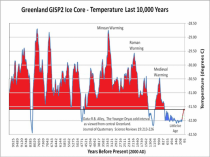
Enlarged
The Minoan Warming Period occurred ~ 3000 years ago
By Verity Jones
In David Archibald’s post over at WUWT Premonitions of the Fall (in temperature) there was a comment from Dr Tim Ball that seemed worth giving a bit of separate life.
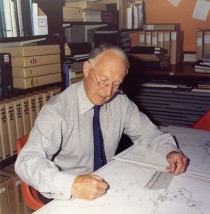
Hubert Lamb, Climatic Research Unit, University of East Anglia (Image source: http://www.aip.org click for link)
The full comment is here but I’ve excerpted most of it:
The IPCC has frozen climate science progress since its inception. Lamb knew what was going to happen as he recorded in his autobiography (1997). He created the Climatic Research Unit (CRU) because
“...it was clear that the first and greatest need was to establish the facts of the past record of the natural climate in times before any side effects of human activities could well be important.”
Lamb foresaw the potential architect for this diversion in the person of Tom Wigley who took over as director of the CRU. In my discussions with Lamb he said he felt his lack of computer skills was limiting. He hired Wigley to fill that gap at the CRU. He learned quickly it was a mistake. Here are his comments from the autobiography.
“The research project which I put forward to the Rockefeller Foundation was awarded a handsome grant, but it sadly came to grief over an understandable difference of scientific judgment between me and the scientists, Dr Tom Wigley, whom we appointed to take charge of the research.”
“The scheme had been to extract the information given in the wealth of descriptive reports of the nature of individual past seasons...”
“My plan was that these reports should be entered on maps of the reported weather character that prevailed in the individual seasons...”
The loss of this project underscores the problems Lamb anticipated because it is from such studies, Lamb recreated without the Rockefeller money, which is the basis for the material in Archibalds comments and Libby and Pandalfi’s predictions.
Lamb identified the problem with Wigley’s appointment and ultimately with the IPCC.
“My immediate successor, Professor Tom Wigley, was chiefly interested in the prospects of world climates being changed as result of human activities, primarily through the burning up of wood, coal, oil and gas reserves...”
“After only a few years almost all the work on historical reconstruction of past climate and weather situations, which first made the Unit well known, was abandoned.”
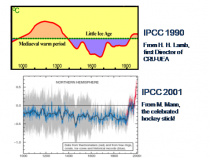
Wigley was instrumental in the application of computer models but as Lamb knew they were only to be as good as the data on which they were built. They were and continue to be a disaster, while Lamb’s work and the studies it engendered proves prescient.
The predictions Libby and Pandolfi made are based on Lamb’s work with midlatitude cyclonic and wind patterns. Wind remains one of the essentially overlooked components in climate studies. Hans Jelbring recognized this, but like any who knew and dared question what the IPCC were doing were subjected to attacks typical of politics rather than the open discourse essential to science.
As a result of this comment, I found myself reading parts of Lamb’s book: Lamb, Hubert H. (1977). Climatic History and the Future. Princeton, NJ: Princeton University Press (at least what I could read in the extended preview). Chapter 19 Manmade Climatic Changes is worth a look. It flows beautifully and is hiughly readable - the mark of a good communicator. It is also refreshingly devoid of bias - in fact it feels almost strange to read such a text, clearly written by a consummate scientist, but completely even-handed in his reporting. We might imagine he regularly rotates in his grave at the current state of writing in climate “science”.
I note his plan was to enter historical data on maps and I rather think that maps presenting Anthony’s Surface Stations Data and/or all the historic reports gathered by TonyB might be rather more true to Lamb’s original intentions than the adjusted, highly homogenised data currently presented to serve the political purpose that so disappointed Lamb.
By Tallbloke
Congratulations to Nicola Scafetta, who has just published another major paper on the relationship between planetary cycles and solar activity variation. This new paper explores a viable physical mechanism which potentially explains the now well known correlations the solar-planetary community has been discovering and documenting here at the Talkshop and elsewhere on the net (see the blog roll). Nicola has been successful in drawing together several of these discoveries and underpinning them with a coherent physical theory. Bravo Nicola! A landmark moment in the development of knowledge about our solar system. I’ll keep this post at the top of the blog while discussion develops.
Does the Sun work as a nuclear fusion amplifier of planetary tidal forcing? A proposal for a physical mechanism based on the mass-luminosity relation.
Nicola Scafetta, 2012
Journal of Atmospheric and Solar-Terrestrial Physics 81–82, 27–40
Abstract
Numerous empirical evidences suggest that planetary tides may influence solar activity. In particular, it has been shown that: (1) the well-known 11-year Schwabe sunspot number cycle is constrained between the spring tidal period of Jupiter and Saturn, 9.93 year, and the tidal orbital period of Jupiter, 11.86 year, and a model based on these cycles can reconstruct solar dynamics at multiple time scales (Scafetta, in press); (2) a measure of the alignment of Venus, Earth and Jupiter reveals quasi 11.07-year cycles that are well correlated to the 11-year Schwabe solar cycles; and (3) there exists a 11.08 year cyclical recurrence in the solar jerk-shock vector, which is induced mostly by Mercury and Venus. However, Newtonian classical physics has failed to explain the phenomenon. Only by means of a significant nuclear fusion amplification of the tidal gravitational potential energy dissipated in the Sun, may planetary tides produce irradiance output oscillations with a sufficient magnitude to influence solar dynamo processes. Here we explain how a first order magnification factor can be roughly calculated using an adaptation of the well-known mass-luminosity relation for main-sequence stars similar to the Sun. This strategy yields a conversion factor between the solar luminosity and the potential gravitational power associated to the mass lost by nuclear fusion: the average estimated amplification factor is A=4.25×10^6. We use this magnification factor to evaluate the theoretical luminosity oscillations that planetary tides may potentially stimulate inside the solar core by making its nuclear fusion rate oscillate. By converting the power related to this energy into solar irradiance units at 1 AU we find that the tidal oscillations may be able to theoretically induce an oscillating luminosity increase from 0.05 - 0.65 W/m2 to 0.25 - 1.63 W/m2, which is a range compatible with the ACRIM satellite observed total solar irradiance fluctuations. In conclusion, the Sun, by means of its nuclear active core, may be working as a great amplifier of the small planetary tidal energy dissipated in it. The amplified signal should be sufficiently energetic to synchronize solar dynamics with the planetary frequencies and activate internal resonance mechanisms, which then generate and interfere with the solar dynamo cycle to shape solar dynamics, as further explained in Scafetta (in press). A section is devoted to explain how the traditional objections to the planetary theory of solar variation can be rebutted.
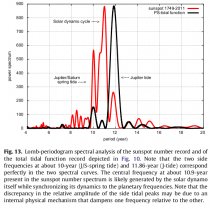
Enlarged
From the conclusion:
The tidal movement consistently and continuously squeezes and stretches the entire Sun from the center to the surface. The solar mass can be moved and mixed by
gravitational tidal forces also because of the fluid nature of the solar plasma. However, even in this case only a tiny fraction of the gravitational tidal energy can be released as heat to the Sun (see Eq. (18)), and nothing would be expected to happen if only released tidal gravitational energy is involved in the process, as Newtonian classical physics would predict. However, a planetary tidal massaging of the solar core should continuously release additional heat to it and also favor plasma fuel mixing. Consequently, the Sun’s nuclear fusion rate should be slightly increased by tidal work and should oscillate with the tidal oscillations. In Section 3.3 we have proposed a methodology to evaluate a nuclear amplification function (Eq. (32)) to convert the gravitational potential power released in the core by tidal work into solar luminosity. The strategy is based on the fact that nuclear fusion inside a solar core is kept active by gravitational forces that continuously compress the core and very slowly release additional gravitational energy to it, as the hydrogen fuses into helium. Without gravitational work, no fusion activity would occur either because the two phenomena are strongly coupled (Carroll and Ostlie, 2007).
The preliminary results of this paper suggest that for better understanding solar activity, the physical interaction between the planets and the Sun cannot be dismissed, as done until now. Future research should better address the nature of these couplings, which could also be used to better forecast solar activity and climate change (Scafetta, 2010, in press). In fact, planetary dynamics can be rigorously predicted.
The full paper is available here.
Closely related papers:
Be sure to visit Nicola Scafetta’s website, where papers and a summary of his work are presented.
Scafetta N., 2012. Multi-scale harmonic model for solar and climate cyclical variation throughout the Holocene based on Jupiter - Saturn tidal frequencies plus the 11-year solar dynamo cycle. Journal of Atmospheric and Solar-Terrestrial Physics 80, 296 - 311.
Tallbloke Scafetta jstides files
Scafetta N., 2012. Testing an astronomically based decadal-scale empirical harmonic climate model versus the IPCC (2007) general circulation climate models. Journal of Atmospheric and Solar-Terrestrial Physics 80, 124 - 137.
Scafetta N., 2012. A shared frequency set between the historical mid-latitude aurora records and the global surface temperature. Journal of Atmospheric and Solar-Terrestrial Physics 74, 145 - 163.
Scafetta N., 2010. Empirical evidence for a celestial origin of the climate oscillations and its implications Original Research Article, Journal of Atmospheric and Solar-Terrestrial Physics 72, 951 - 970.
Scafetta N., 2009. Empirical analysis of the solar contribution to global mean air surface temperature change Original Research Article, Journal of Atmospheric and Solar-Terrestrial Physics 71, 1916 - 1923.
Rational thought underlies conservative Christian views on climate change and the environment
David R. Legates
Although he has rarely been willing to discuss or debate energy or environmental issues with those who do not share his views, environmentalist David Suzuki frequently
challenges them on other grounds. In his recent article, “Religious Right is wrong about climate change,” Suzuki claims that some US and Canadian scientists hold religious views that are anti-science.
Suzuki asserts that some climate scientists - including me, by name - put “misguided beliefs above rational thought.” His implicit assumption is that conservative Christian views are irrational and incompatible with science, and that I have replaced Almighty God with the “almighty dollar,” believing the economy matters more than the environment.
As a coauthor of the Cornwall Alliance’s Renewed Call to Truth, Prudence, and Protection of the Poor: An Evangelical Examination of the Theology, Science and Economics of Global Warming, which forms the basis for the Evangelical Declaration on Global Warming that Suzuki criticizes, I know the Cornwall Alliance fully and carefully integrates scientific, economic, ethical and theological reasoning to support its conclusions. There’s nothing at all irrational about it - unless you consider religion irrational per se.
However, Suzuki is correct regarding one aspect of my belief: the economy does matter as much as the environment. Good environmental stewardship requires sound financial footing - and improving and safeguarding human health and welfare requires maintaining a strong, vibrant, innovative economy that can sustain continued environmental progress.
When a country is in dire need of food, clothing, shelter and other necessities for life, it cannot possibly be concerned with environmental issues. The poor people of India pour untreated sewage into the Ganges River - and then draw their drinking and “cleaning” water from it. So poor that they’re desperate simply for survival, they cannot possibly concern themselves with environmental stewardship. Only when economic improvements allow technological advancements to increase the quality of life, provide ample food and clothing, house citizens, provide clean drinking water, and treat and eradicate diseases can a thus wealthier society turn its attention to caring for the environment.
That is precisely what has happened in more developed nations. As the United States and Canada advanced economically, we developed technologies and policies that increased our quality and length of life. In turn, this has led us to be more proactive with our environmental stewardship.
We emit far less pollution and waste today, both per person and per unit of production, than we did fifty years ago. We feed more people with every parcel of land, we get more energy from every drop of oil, we are more efficient at everything we do, and we are much better stewards of our environment. But none of that could have occurred without a strong and developing economy.
Unfortunately, some so-called environmentalists wish to keep Africa and other developing nations in perpetual underdevelopment. They pay them off to be “environmentally conscious,” by giving them handouts - food and monetary aid - to keep them alive and perhaps have little solar panels on their huts. But they also ensure that those poor families never prosper or become middle class - so as to perpetuate environmentalist notions of “noble natives,” supposedly “at one” with their environment and living a “sustainable” existence.
Equally harmful, much of that money is lost to corruption, while the people are forced to continue living in a state of poverty, disease, malnutrition and deprivation, as technologies that could enhance their length and quality of life are denied to them. Among the technologies denied are modern seeds, fertilizers, and high-tech, high-yield farming methods to increase food supplies; natural gas and electricity to heat homes and cook food, instead of cutting down forests and burning wood, thereby degrading indoor air quality and causing lethal lung infections; refrigeration so that people do not have to choose between eating spoiled food and going hungry; and the use of insecticides, including the powerful insect repellant DDT, to spare them from the agonizing illness and death brought on by malaria.
Each of these enhancements requires plentiful, dependable, affordable energy. Yet in the name of “saving the planet” or “preventing cataclysmic climate change,” environmentalists like Suzuki deny developing countries the modern technologies and energy they need to improve their lives and environment - thereby perpetuating high infant mortality, significantly shortened life spans, and greatly decreased quality of life.
Climate alarmism is the rationale for these deadly policies - and that is where political ideology mixes with the new religion of environmentalism. Overstated or non-existent threats to the environment, along with impractical or imaginary ways to prevent the purported threats, are the new scripture on which the adherents develop their theologies and policies for directing and micromanaging the course of human events. Unfortunately, these eco-religionists never encounter (or intentionally avert their eyes from) the misery and devastation that their policies dramatically inflict on the world’s poorest people. That is because they are too concerned with “saving the planet.”
Back in North America, some wish to have energy rationed or be made increasingly expensive, creating artificial fuel poverty for millions. Such policies will make food, clothing, shelter, transportation, and medical care - in short, everything - more expensive and scarce, create more unemployed workers, push many people back into conditions of poverty and deprivation, and gravely impair human health and welfare. This strategy will not save the planet, as they hope, because one of its first casualties will be environmental stewardship. History and human nature both testify that, forced by economic limits to choose between a cleaner environment and food on the table, people always choose food.
In the Parable of the Talents, Jesus told of a master who gave one of his servants a single talent, and then condemned him for hiding it in the earth and not putting it to use. Often we think of the talent only as money or ability, but it really stands for every resource - including natural resources. How will the Master of all creation judge us if we hide our resources in the earth, and then on Judgment Day say, “Behold, you have what is yours”?
If we do not use the resources God has set before us in the earth to care for those in need, our Creator will likely condemn us, saying: “You kept buried what I gave you, instead of using and investing it. You failed to employ my gifts to care for the poor, the hungry, the sick, and those who were dying from disease. You have been worthless, irresponsible stewards of my creation.” We would deserve the same fate as the servant the master called “wicked and lazy.”
I fail to understand how anyone thinking rationally can argue that poverty and economic hardship will enhance environmental stewardship, or that the planet is more important than the people who live on it. PDF
_________
David R. Legates is a Professor of Climatology at the University of Delaware in Newark, Delaware, USA. He is a Christian and a senior fellow of the Cornwall Alliance for the Stewardship of Creation.
Steve Goddard, Real Science Blog
NOAA’s extreme weather expert, Martin Hoerling, slammed Hansen on Andy Revkin’s blog yesterday.
“Over the next several decades, the Western United States and the semi-arid region from North Dakota to Texas will develop semi-permanent drought, with rain, when it does come, occurring in extreme events with heavy flooding. Economic losses would be incalculable. More and more of the Midwest would be a dust bowl. California’s Central Valley could no longer be irrigated. Food prices would rise to unprecedented levels.”
He doesnt define “several decades,” but a reasonable assumption is that he refers to a period from today through mid-century. I am unaware of any projection for “semi-permanent” drought in this time frame over the expansive region of the Central Great Plains. He implies the drought will be due to a lack of rain (except for the brief, and ineffective downpours). I am unaware of indications, from model projections, for a material decline in mean rainfall. Indeed, that region has seen a general increase in rainfall over the long term during most seasons (certainly no material decline). Also, for the warm season when evaporative loss is especially effective, the climate of the central Great Plains has not become materially warmer (perhaps even cooled) since 1900. In other words, climate conditions in the growing season of the Central Great Plains are today not materially different from those existing 100 years ago. This observational fact belies the expectations from climate simulations and, in truth, our science lacks a good explanation for this discrepancy.
The Hansen piece is policy more than it is science, to be sure, and one can read it for the former. But facts should, and do, matter to some. The vision of a Midwest Dustbowl is a scary one, and the author appears intent to instill fear rather than reason.
The article makes these additional assertions:
“The global warming signal is now louder than the noise of random weather…
This is patently false. Take temperature over the U.S. as an example. The variability of daily temperature over the U.S. is much larger than the anthropogenic warming signal at the time scales of local weather. Depending on season and location, the disparity is at least a factor of 5 to 10.
I think that a more scientifically justifiable statement, at least for the U.S. and extratropical land areas is that daily weather noise continues to drum out the siren call of climate change on local, weather scales.
Hansen goes on to assert that:
“Extremely hot summers have increased noticeably. We can say with high confidence that the recent heat waves in Texas and Russia, and the one in Europe in 2003, which killed tens of thousands, were not natural events - they were caused by human-induced climate change.”
Published scientific studies on the Russian heat wave indicate this claim to be false. Our own study on the Texas heat wave and drought, submitted this week to the Journal of Climate, likewise shows that that event was not caused by human-induced climate change. These are not de novoevents, but upon scientific scrutiny, one finds both the Russian and Texas extreme events to be part of the physics of what has driven variability in those regions over the past century. This is not to say that climate change didn’t contribute to those cases, but their intensity owes to natural, not human, causes.
The closing comment by Hansen is then all the more ironic, though not surprising knowing he often writes from passion and not reason:
“The science of the situation is clear - it’s time for the politics to follow.”
Let me borrow from a recent excellent piece in New Scientist by tornado expert Dr. Harold Brooks regarding the global warming and tornado debate, and state:
“Those who continue to talk in certain terms of how local weather extremes are the result of human climate change are failing to heed all the available evidence.”
Varied Views on Extreme Weather in a Warming Climate - NYTimes.com
Steve Goddard also shows here how In 1999, Hansen himself said that he didn’t see much happening in the US.
Empirical evidence does not lend much support to the notion that climate is headed precipitately toward more extreme heat and drought. The drought of 1999 covered a smaller area than the 1988 drought, when the Mississippi almost dried up. And 1988 was a temporary inconvenience as compared with repeated droughts during the 1930s “Dust Bowl” that caused an exodus from the prairies, as chronicled in Steinbeck’s Grapes of Wrath.
Steve goes on to show “Need your climate adjusted? - call Dr. James Hansen at GISS. Below is a chronology of the destruction of the data for Hansen’s political cause.”
-----------------
Earth Day predictions of 1970. The reason you shouldn’t believe Hansen’s dire NYT projections
Ihatethemedia.com
Ignore them. They’ll be wrong. We’re confident in saying that because they’ve always been wrong. And always will be.
Need proof? Here are some of the hilarious, spectacularly wrong predictions made on the occasion of Earth Day 1970.
“We have about five more years at the outside to do something.” Kenneth Watt, ecologist
“Civilization will end within 15 or 30 years unless immediate action is taken against problems facing mankind.” George Wald, Harvard Biologist
“We are in an environmental crisis which threatens the survival of this nation, and of the world as a suitable place of human habitation.” Barry Commoner, Washington University biologist
“Man must stop pollution and conserve his resources, not merely to enhance existence but to save the race from intolerable deterioration and possible extinction.” New York Times editorial, the day after the first Earth Day
“Population will inevitably and completely outstrip whatever small increases in food supplies we make. The death rate will increase until at least 100-200 million people per year will be starving to death during the next ten years.” Paul Ehrlich, Stanford University biologist BTW, the real ‘denialist’ Erlich claims his projections were correct
“By...[1975] some experts feel that food shortages will have escalated the present level of world hunger and starvation into famines of unbelievable proportions. Other experts, more optimistic, think the ultimate food-population collision will not occur until the decade of the 1980s.” Paul Ehrlich, Stanford University biologist
“It is already too late to avoid mass starvation.” Denis Hayes, chief organizer for Earth Day
“Demographers agree almost unanimously on the following grim timetable: by 1975 widespread famines will begin in India; these will spread by 1990 to include all of India, Pakistan, China and the Near East, Africa. By the year 2000, or conceivably sooner, South and Central America will exist under famine conditions...By the year 2000, thirty years from now, the entire world, with the exception of Western Europe, North America, and Australia, will be in famine.” Peter Gunter, professor, North Texas State University
“Scientists have solid experimental and theoretical evidence to support...the following predictions: In a decade, urban dwellers will have to wear gas masks to survive air pollution...by 1985 air pollution will have reduced the amount of sunlight reaching earth by one half...” Life Magazine, January 1970
“At the present rate of nitrogen buildup, it’s only a matter of time before light will be filtered out of the atmosphere and none of our land will be usable.” Kenneth Watt, Ecologist
Stanford’s Paul Ehrlich announces that the sky is falling: “Air pollution...is certainly going to take hundreds of thousands of lives in the next few years alone.” Paul Ehrlich, Stanford University biologist
“We are prospecting for the very last of our resources and using up the nonrenewable things many times faster than we are finding new ones.” Martin Litton, Sierra Club director
“By the year 2000, if present trends continue, we will be using up crude oil at such a rate...that there won’t be any more crude oil. You’ll drive up to the pump and say, ‘Fill ‘er up, buddy,’ and he’ll say, ‘I am very sorry, there isn’t any.’” Kenneth Watt, Ecologist
“Dr. S. Dillon Ripley, secretary of the Smithsonian Institute, believes that in 25 years, somewhere between 75 and 80 percent of all the species of living animals will be extinct.” Sen. Gaylord Nelson
“The world has been chilling sharply for about twenty years. If present trends continue, the world will be about four degrees colder for the global mean temperature in 1990, but eleven degrees colder in the year 2000. This is about twice what it would take to put us into an ice age.” Kenneth Watt, Ecologist
Keep these predictions in mind when you hear the same predictions made today. They’ve been making the same predictions for 42 years. And they’re going to continue making them until...well...forever.
Here we are, 42 years later and the economy sucks, but the ecology’s fine. In fact this planet is doing a lot better than the planet on which those green lunatics live.
You’ll also enjoy (or hate) our article, 25 Global Warming Debunking Videos Al Gore Doesn’t Want You To See.
By P Gosselin on 9. May 2012
Meteorologist Klaus-Eckard Puls
Physicist and meteorologist Klaus-Eckart Puls was interviewed by Bettina Hahne-Waldscheck of the Swiss magazine “factum”.
I’ve translated and summarised the interview, paraphrasing for brevity.
factum: You’ve been criticizing the theory of man-made global warming for years. How did you become skeptical?
Puls: Ten years ago I simply parroted what the IPCC told us. One day I started checking the facts and data - first I started with a sense of doubt but then I became outraged when I discovered that much of what the IPCC and the media were telling us was sheer nonsense and was not even supported by any scientific facts and measurements. To this day I still feel shame that as a scientist I made presentations of their science without first checking it. The CO2-climate hysteria in Germany is propagated by people who are in it for lots of money, attention and power.
factum: Is there really climate change?
Puls: Climate change is normal. There have always been phases of climate warming, many that even far exceeded the extent we see today. But there hasn’t been any warming since 1998. In fact the IPCC suppliers of data even show a slight cooling.
factum: The IPCC is projecting 0.2C warming per decade, i.e. 2 to 4C by the year 2100. What’s your view?
Puls: These are speculative model projections, so-called scenarios - and not prognoses. Because of climate’s high complexity, reliable prognoses just aren’t possible. Nature does what it wants, and not what the models prophesize. The entire CO2-debate is nonsense. Even if CO2 were doubled, the temperature would rise only 1C. The remainder of the IPCC’s assumed warming is based purely on speculative amplification mechanisms. Even though CO2 has risen, there has been no warming in 13 years.
factum: How does sea level rise look?
Puls: Sea level rise has slowed down. Moreover, it has dropped a half centimeter over the last 2 years. It’s important to remember that mean sea level is a calculated magnitude, and not a measured one. There are a great number of factors that influence sea level, e.g. tectonic processes, continental shifting, wind currents, passats, volcanoes. Climate change is only one of ten factors.
factum: What have we measured at the North Sea?
Puls:In the last 400 years, sea level at the North Sea coast has risen about 1.40 meters. That’s about 35 centimeters per century. In the last 100 years, the North Sea has risen only 25 centimeters.
factum: Does the sea level rise have anything to do with the melting North Pole?
Puls: That’s a misleading conclusion. Even if the entire North Pole melted, there would be no sea level rise because of the principles of buoyancy.
factum: Is the melting of the glaciers in the Alps caused by global warming?
Puls: There are many factors at play. As one climbs a mountain, the temperature drops about 0.65C per 100 meters. Over the last 100 years it has gotten about 0.75°C warmer and so the temperature boundary has shifted up about 100 meters. But observations tell us that also ice 1000 meters up and higher has melted. Clearly there are other reasons for this, namely soot and dust. But soot and dust do not only have anthropogenic origins; they are also caused by nature via volcanoes, dust storms and wildfires. Advancing and retreating of glaciers have always taken place throughout the Earth’s history. Glaciology studies clearly show that glaciers over the last 10,0000 years were smaller on average than today.
factum: In your view, melting Antarctic sea ice and the fracture of a huge iceberg 3 years ago are nothing to worry about?
Puls: To the contrary, the Antarctic ice cap has grown both in area and volume over the last 30 years, and temperature has declined. This 30-year trend is clear to see. The Amundsen Scott Station of the USA shows that temperature has been declining there since 1957. 90% of the Earth’s ice is stored in Antarctica, which is one and half times larger than Europe.
factum: Then why do we always read it is getting warmer down there?
Puls: Here they are only talking about the West Antarctic peninsula, which is where the big chunk of ice broke off in 2008 - from the Wilkins-Shelf. This area is hardly 1% of the entire area of Antarctica, but it is exposed to Southern Hemisphere west wind drift and some of the strongest storms on the planet.
factum: What causes such massive chunks of ice to break off?
Puls: There are lots of factors, among them the intensity of the west wind fluctuations. These west winds have intensified over the last 20 years as part of natural ocean and atmospheric cycles, and so it has gotten warmer on the west coast of the Antarctic peninsula. A second factor are the larger waves associated with the stronger storms. The waves are more powerful and so they break off more ice. All these causes are meteorological and physical, and have nothing to do with a climate catastrophe.
factum: Then such ice breaks had to have occurred in the past too?
Puls: This has been going on for thousands of years, also in the 1970s, back when all the talk was about “global cooling”. Back then there were breaks with ice chunks hundreads of square kilometers in area. People were even discussing the possibilities of towing these huge ice chunks to dry countries like South Africa or Namibia in order to use them as a drinking water supply.
factum: What about all the media photos of polar bears losing their ice?
Puls: That is one of the worst myths used for generating climate hysteria. Polar bears don’t eat ice, they eat seals. Polar bears go hungry if we shoot their food supply of seals. The polar bear population has increased with moderately rising temperatures, from 5000 50 years ago to 25,000 today.
factum: But it is true that unlike Antarctica, the Arctic is melting?
Puls: It has been melting for 30 years. That also happened twice already in the last 150 years. The low point was reached in 2007 and the ice has since begun to recover. There have always been phases of Arctic melting. Between 900 and 1300 Greenland was green on the edges and the Vikings settled there.
factum: And what do you say about the alleged expanding deserts?
Puls: That doesn’t exist. For example the Sahara is shrinking and has lost in the north an area as large as Germany over the last 20 years. The same is true in the South Sahara. The famine that struck Somalia, Kenya and Ethiopia was mainly caused by the leasing of large swaths of land to large international corporations so that they could grow crops for biofuels for Europe, and by war. But it is much easier for prosperous Europe to blame the world’s political failures on a fictional climate catastrophe instead.
factum: So we don’t need to do anything against climate change?
Puls: There’s nothing we can do to stop it. Scientifically it is sheer absurdity to think we can get a nice climate by turning a CO2 adjustment knob. Many confuse environmental protection with climate protection. it’s impossible to protect the climate, but we can protect the environment and our drinking water. On the debate concerning alternative energies, which is sensible, it is often driven by the irrational climate debate. One has nothing to do with the other.
-----------------
See 10 Theses of Contention on the Power and Efficacy of ‘Anthropogenic Global Warming’ Theory by Jorge Gato.





